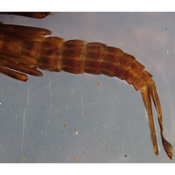| Distinguishing Characteristics | |||||||||||||||
|
|||||||||||||||
| Additional Pictures | |||||||||||||||
|
|||||||||||||||
| Ecology | |||||||||||||||
| Habitat
Coenagrionidae are common throughout North America and are found primarily in lentic habitats (1, 2). A few species within the family are found along the banks or in riffles of streams (1). Vegetative debris in permanent ponds, swamps, marshes, and littoral lakes are ideal habitats for larvae of lentic species (1). Feeding Behavior Categorized as ambush and engulfing predators, Coenagrionidae use the vegetation as camouflage to stalk their prey, consuming primarily small invertebrates (1). The majority of Coenagrionidae species are climbers; organisms that use branches, stems, or rocks to perch on and look for prey (2). The feeding behavior of most Odonates follow a similar pattern; 1) locate prey and adjust body to face it, 2) project labium and grasp the prey then retracting labium back to mouth, and 3) use mandibles to consume its prey (2). Life History Most Coenagrionidae are univoltine with a few species being bivoltine. Adult flying periods range from spring to autumn, during which, females deposit the eggs in vegetation (1). Some species produce eggs that are able to over-winter. These species usually deposit eggs in autumn and the larvae emerge in the spring (1). Behavior Members of the Coenagrionidae family have territorial and defensive behaviors (3). Larvae in their 6-8th (middle) and 12-14th (late) instars of the species Xanthocnemis zealandica were observed in New Zealand. Twenty-five different body movements were recorded and were associated with predation threat, intraspecific competition, and territorial behavior (3). Four common movements were the standing posture, abdomen raise, lamellae forward, and static caudal swinging (SCS) (3). Other Coenagrionidae are characterized as being associated with natural water conditions instead of pollutant tolerant (4). This suggests that bodies of water where Coenagrionidae are found are less likely influenced by human impact or outside disturbances. |
|||||||||||||||
| QuickTime Movies | |||||||||||||||
| Additional Links | |||||||||||||||
| Bibliography | |||||||||||||||
|



